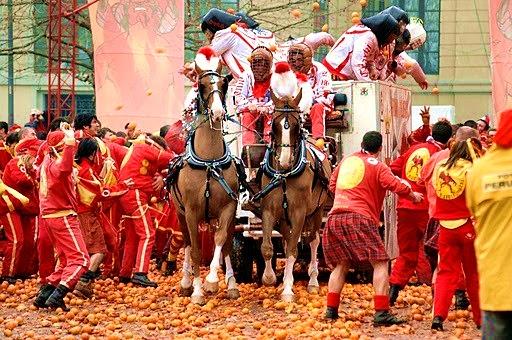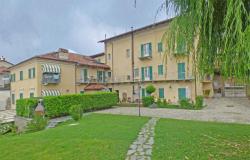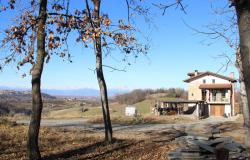Ivrea’s long Carnival starts on Twelfth night. On the Twelfth night of 200 years ago, to be precise. Some of the town’s Carnival traditions date from the Middle Ages—such as the Scarlo, a heather-covered stake which is burned to celebrate the end of the festival. Until the end of the 18th century, however, the revels were the spontaneous, somewhat haphazard expression of a lively community, with each parish organising its own celebrations.
With the onset of the 19th century, things changed dramatically. The local rulers, appointed by Napoleon’s conquering army, saw the festival as the perfect tool to forge the town’s cultural identity and link it to the ideals of the French revolution.
Ivrea’s many parish Carnivals thus became one single festival, which in turn came to symbolise the fight of the oppressed for their freedom. Over the years, Ivrea’s Carnival acquired legendary characters that embodied the common people’s battle for liberty. There is the Podestà—a reveller dressed up as a medieval city administrator—who throws a stone in the Dora River in defiance to the tyrannical power of the Marquis of Monferrato; the General in charge of the revels, who represents those crafty Napoleonic rulers that first transformed Ivrea’s Carnival; and most of all, la Mugnaia, the miller’s daughter.
Story has it that, in the Middle Ages, Violetta, the beautiful daughter of a local miller, was abducted by a local lord, who wanted to have his way with her. However, she managed to kill him and escape unscathed. La Mugnaia celebrates this triumph of the common people against a cruel tyrant, but, dressed in the colours of the Italian flag, she is also a symbol of Italy’s fight for independence—after all, her character was introduced in 1858, at the height of the country’s Unification movement.
Together, La Mugnaia and the other characters re-enact scenes from Ivrea’s history, lead the parades and oversee crucial moments of the Carnival revels—from distributing free bean and sausage stew to people in the streets to digging holes for the Scarlo stakes. In particular, La Mugnaia, who is only made known to the people of Ivrea on the last Saturday of Carnival, also gives away sweets and yellow mimosas to revellers on Shrove Tuesday.
On the same day, the celebrated battle of the oranges takes place. Started in the 19th century but established after the Second World War, it sees a group of guards aboard lavish carriages fight against common people on foot. The symbolism is obvious—but the duel is very real. Hundreds of throwers pelt oranges at one another with energy and gusto, ending up covered in juice, squashed pulp and the odd bruise.
After dark, it is time for the Scarlo stakes to go up in flame. As they burn under the watchful eye of Mugnaia, General and Podestà, a song echoes in the streets marking the end of Carnival, but also the end of tyranny: “Once upon a time it is true that a Baron treated us harshly. From the height of his castle, where he had home and strength, he gobbled us up flesh and bones, laughing like a madman. But a miller’s daughter taught him a lesson. That was a sign for us, and the castle is no longer there.”














